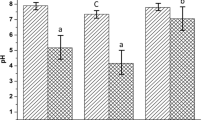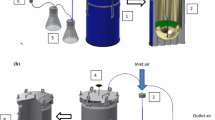Abstract
Organic wastes are increasingly collected source separated, thus requiring additional treatment or recovery capacities for municipal biowastes, organic industrial wastes, as well as agroindustrial byproducts. In this study, we demonstrate that anaerobic digestion is preferentially suited for high-water-containing liquid or pasty waste materials. We also evaluate the suitability of various organic wastes and byproducts as substrates for anaerobic digestion and provide a current status survey of codigestion. Biodegradation tests and estimations of the biogas yield were carried out with semisolid and pasty proteins and lipids containing byproducts from slaughterhouses; pharmaceutical, food, and beverage industries; distilleries; and municipal biowastes. Biogas yields in batch tests ranged from 0.3 to 1.36 L/g of volatile solidsadded. In continuous fermentation tests, hydraulic retention times (HRTs) between 12 and 60 d, at a fermentation temperature of 35°C, were required for stable operation and maximum gas yield. Laboratory experiments were scaled up to full-scale codigestion trials in municipal and agricultural digestion plants. Up to 30% cosubstrate addition was investigated, using municipal sewage sludge as well as cattle manure as basic substrate. Depending on addition rate and cosubstrate composition, the digester biogas productivity could be increased by 80–400%. About 5–15% cosubstrate addition proved to be best suited, without causing any detrimental effects on the digestion process or on the further use of the digestate.
Similar content being viewed by others
References
Schmelz, K.-G. (2000), Paper presented at the Symposium Kommunale Chance: Energie aus Biomasse, 25. 5. 2000 Gießen, Inst. für kommunale Wirtschaft und Umweltplanung, Wiesbaden, Germany.
IONICS ITALBA. (1989), Technical report, Ionics Italba, Milano, Italy.
OWS. (1997), DRANCO—Anlagen Referenzliste, Fa. Organic Waste Systems, Gent, Belgium.
Edelmann, W. and Engeli, H. (1998), Co-Vergärung von festen und flüssigen Substraten, study of the Nationaler Energieforschungsfonds, NEFF of the Kanton Bern, Arbeitsgemeinschaft Bioenergie und AG für Abfallverwertung, Maschwanden, Switzerland.
Braun, R. (1998), Anaerobtechnologie für die mechanisch—biologische Vorbehandlung von Restmüll und Klärschlamm, Band 10, Schriftenreihe Federal Ministry of Environment, Vienna, Austria.
Schmelz, K.-G. and Tatus, R. (1999), in Bio- und Restabfallbehandlung III, Wiemer, K. and Kern, M., eds., M. I. C. Baeza Press, Witzenhausen, Germany, pp. 365–388.
CITEC. (2000), References list, CITEC, Vaasa, Finland.
Langhans, G. (2000), Abfall Brief—Magazin zur Abfallpraxis 7(2), 7–9.
Pavan, P., Battistoni, P., Bolzonella, D., Innocenti, L., Traverso, P., and Checchi, F. (2000), in Proceedings of the 4th International Symposium on Environmental Biotechnology, Hartmans, S. and Lens, P., eds.
Schmelz, K.-G. (2000), in Co-Vergärung von Klärschlamm und Bioabfällen, Bidlingmaier, W., ed., Rhombos Press, Berlin, pp. 1–220.
Bro, B. (2000), Paper presented at the symposium Kick-off for a Future Development of Biogas Technology, Swedish National Energy Administration, Eskilstuna, Sweden.
GBA. (2001), Biogas Nutzung in Deutschland, Stand 28. 2. 2001, Neue Energie, Magazin für erneuerbare Energien (ed.), Fachverband Biogas e. V., Freising, Germany (biogas@t-online.de).
Membrez, Y. and Fruteau de Laclos, H. (2001), in Proceedings of the 9th World Congress on Anaerobic Digestion 2002, Pt. 1, Van Velsen, A. F. M. and Verstraete, W. H., eds., Technology Institute vzw, Antwerp, Belgium, pp. 581–584.
Graf, W., Maier, H., Krotschek, C., and Puchas, K. (2001), Biogas Handbuch, Lokale Energieagentur Oststeiermark (ed.), Feldbach, Austria.
Al Seadi, T. (2000), Danish Centralized Biogas Plants—Plant Descriptions, Jens Bo Holm-Nielsen, ed., Bioenergy Department, University of Southern Denmark, Esbjerg.
Hjort-Gregersen, K. (2000), Paper presented at the symposium Kick-off for a Future Development of Biogas Technology, Swedish National Energy Administration, Eskilstuna, Sweden.
Lindberg, A. (2000), Paper presented at the symposium Kick-off for a Future Development of Biogas Technology, Swedish National Energy Administration, Eskilstuna, Sweden.
Kern, M. (1999), in Bio- und Restabfallbehandlung III, Wiemer, K. and Kern, M., eds., M. I. C. Baeza Press, Witzenhausen, pp. 293–321.
Hoppenheidt, K. and Mücke, W. (1999), Study on behalf of Bayerisches Landesamt für Umweltschutz, Bayerisches Landesamt für Umweltschutz, BlfA-Texte Nr. 11, Augsburg, Germany.
Braun, R. (2001), Stand der Technik der Bioabfallvergärung, Study on behalf of the Umweltanwaltschaft Wien, Vienna, Austria.
Wellinger, A. (2000), Paper presented at the symposium Kick-off for a Future Development of Biogas Technology, Swedish National Energy Administration, Eskilstuna, Sweden.
Brolin, L. and Kättström, L. (2000), Paper presented at the symposium Kick-off for a Future Development of Biogas Technology, Swedish National Energy Administration, Eskilstuna, Sweden.
Holm-Nielsen, J. B. and Al Seadi, T. (1997), Final Report EU Altener Programme, contract no. 4. 1030/D/95-006, University of Southern Denmark, Esbjerg.
DEV. (2001), Deutsche Einheitsverfahren zur Wasser- und Abwasseruntersuchung, Wiley-VCH, Weinheim, Germany.
Brachtl, E. (2000), PhD thesis, University of Agriculture and Forestry, Vienna, Austria.
Grasmug, M., Wellacher, M., and Braun, R. (2001), in Proceedings of the 9th World Congress on Anaerobic Digestion, Part 2, Van Velsen, L. and Verstraete, W., eds., Technological Institute Belgium, Antwerp, pp. 349–352.
European Commission. (2001), Biological Treatment of Bio-waste—Guideline 2nd draft, Directorate General Environment, Brussels, Belgium.
European Commission. (2001), Regulation of the EU Parliament on Health Rules Concerning Animal By-Products COM (2001) 748 final, Directorate General Environment, Brussels, Belgium.
Grasmug, M. (2001), Paper presented at the workshop Co-fermentation in kommunalen Kläranlagen, IFA Tulln, Austria.
Braun, R., Steinlechner, K., Steffen, R., and Steyskal, F. (1995), Symposium Proceedings No. 14, 27–43, Braun, R., ed., Environmental Agency, Vienna, Austria.
Author information
Authors and Affiliations
Corresponding author
Rights and permissions
About this article
Cite this article
Braun, R., Brachtl, E. & Grasmug, M. Codigestion of proteinaceous industrial waste. Appl Biochem Biotechnol 109, 139–153 (2003). https://doi.org/10.1385/ABAB:109:1-3:139
Issue Date:
DOI: https://doi.org/10.1385/ABAB:109:1-3:139




